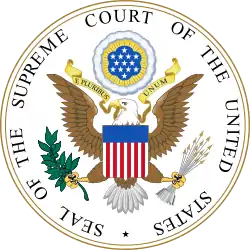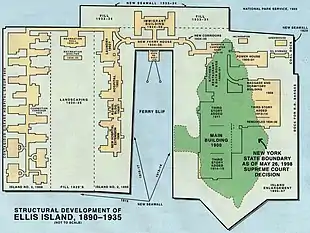New Jersey v. New York
New Jersey v. New York, 523 U.S. 767 (1998), was a United States Supreme Court case in which it was determined that roughly 83% of Ellis Island was part of New Jersey rather than New York.
| New Jersey v. New York | |
|---|---|
 | |
| Argued January 12, 1998 Decided May 26, 1998 | |
| Full case name | State of New Jersey v. State of New York |
| Citations | 523 U.S. 767 (more) 118 S. Ct. 1726; 140 L. Ed. 2d 993; 1998 U.S. LEXIS 3405; 66 U.S.L.W. 4389; 98 Daily Journal DAR 5406; 1998 Colo. J. C.A.R. 2596; 11 Fla. L. Weekly Fed. S 563 |
| Holding | |
| New Jersey has sovereign authority over the filled land added to the original Island. New Jersey's exception to that portion of the Special Master's report concerning the Court's authority to adjust the original boundary line between the two States is sustained. The other exceptions of New Jersey and New York are overruled. | |
| Court membership | |
| |
| Case opinions | |
| Majority | Souter, joined by Rehnquist, O'Connor, Kennedy, Ginsburg, Breyer |
| Concurrence | Breyer, joined by Ginsburg |
| Dissent | Stevens |
| Dissent | Scalia, joined by Thomas |
| Laws applied | |
| 1834 Compact between New York and New Jersey | |
History
The circumstances which led to an exclave of New York being located within New Jersey began in the colonial era, after the British takeover of New Netherland in 1664. An unusual clause in the colonial land grant outlined the territory that the proprietors of New Jersey would receive as being "westward of Long Island, and Manhitas Island and bounded on the east part by the main sea, and part by Hudson's river",[1] rather than at the river's midpoint, as was common in other colonial charters.[2]
Attempts were made as early as 1804 to resolve the status of the state line.[3] The City of New York claimed the right to regulate trade on all the waters. This was contested in Gibbons v. Ogden, which decided that the regulation of interstate commerce fell under the authority of the federal government, thus influencing competition in the newly developing steam ferry service in New York Harbor.[4] In 1830, New Jersey planned to bring suit to clarify the border, but the case was never heard.[5] The matter was resolved with a compact between the states, ratified by U.S. Congress in 1834, which set the boundary line between them as the middle of the Hudson River and New York Harbor, but granted all the islands in the channel to New York.[5][6][7][8] This was later confirmed by the U.S. Supreme Court in other cases which also expounded on the compact.[9][10][11]

The federal government began expanding the island by land reclamation in the late 19th century to accommodate its immigration station, and the expansions continued in stages until 1934.[12] New Jersey contended that the artificial portions of the island were part of New Jersey, since they were outside New York's border.[13] Jurisdictional disputes reemerged in the 1980s with the renovation of Ellis Island,[14] and then again in the 1990s with the proposed redevelopment of the south side.[15] New Jersey sued in 1997.[16][15] Since the land added by the federal government was not expressly granted to New York by the interstate compact, and was placed in water that had been expressly granted to New Jersey, the majority ruled that this "new" land (decades old by this time) must belong to New Jersey. The minority dissent used historical reasons and "common-sense inference" as their basis for supporting New York's claim.[17]
Aftermath
According to the court decision, all land originally given to New York by the compact (the original, natural Ellis Island) remains under the jurisdiction of New York, but any and all land reclaimed from the waters after that point is under the jurisdiction of New Jersey.[18] The island covers a land area of 27.5 acres (11.1 ha).[19][20][21]
The two states jointly negotiated a post-trial settlement to decide exactly where and how to draw the lines in accordance with the Supreme Court decision. The 2.74-acre (1.11 ha) original island and other areas negotiated in that post-trial settlement, totaling 4.68 acres (1.89 ha), to this day remains part of New York that is a landlocked enclave within New Jersey.[19][20][21] The case is possibly the first to use GIS in determining a Supreme Court decision.[22]
Although the court decision has changed the state territorial sovereignty of most parts of the island, the actual current landowner (holder of the title of Ellis Island) is the federal government. Very few activities on the island were directly affected by the transfer of sovereignty, but the decision did affect some instances of sales taxes.[18]
References
- "The Federal and State constitutions, colonial charters, and other organic laws of the state[s], territories, and colonies now or heretofore forming the United States of America /compiled and edited under the Act of Congress of June 30, 1906". December 18, 1998.
- Rieff, Henry, "Interpretations of New York-New Jersey Agreements 1834 and 1921" (PDF), Newark Law Review
- "Ellis Island Its Legal Status" (PDF). General Services Administration Office of General Counsel. February 28, 1963. Archived from the original (PDF) on August 31, 2009. Retrieved September 25, 2010. Cite journal requires
|journal=(help) - Gibbons v. Ogden, 22 U.S. (9 Wheat.) 1 (1824)
- Greenhouse, Linda (May 27, 1998). "THE ELLIS ISLAND VERDICT: THE RULING; High Court Gives New Jersey Most of Ellis Island". The New York Times. ISSN 0362-4331. Retrieved June 6, 2019.
- Beyer Blinder Belle; Anderson Notter Finegold (1988). "Historic Structure Report: The Main Building, Ellis Island, Statue of Liberty National Monument". Internet Archive. p. 11.
- Stakely, Tracy (May 2003). Cultural Landscape Report for Ellis Island (PDF). Olmsted Center for Landscape Preservation. p. 18.
- "Statue of Liberty National Monument - Frequently Asked Questions". NPS.gov. National Park Service. Retrieved February 1, 2010.
- "Central R. Co. of New Jersey v. Jersey City 209 U.S. 473 (1908)".
- Application of Devoe Manufacturing Company for a Writ of Prohibition/Opinion of the Court, 108 U.S. 401 (1882).
- "Ellis Island Its Legal Status" (PDF). General Services Administration Office of General Counsel. February 11, 1963. Archived from the original (PDF) on August 4, 2012. Cite journal requires
|journal=(help) - "Ellis Island, New Jersey, in Upper New York Bay, was the gateway for over 12 million immigrants to the United States as the nation's busiest immigrant inspection station for over sixty years from 1892 until 1954". Home | Library of Congress. August 24, 2017. Retrieved July 14, 2019.
- Logan, Andy; McCarten, John (January 14, 1956). "Invasion from Jersey". The New Yorker. Retrieved February 14, 2011.
- Moritz, Owen (June 20, 1982). "A tale of two cities: Both claim Ellis Island". New York Daily News. p. 75. Retrieved June 5, 2019 – via newspapers.com

- Seitz, Sharon (April 2, 1997). "Ellis Island mostly in N.J." Central New Jersey Home News. pp. 1, 6 – via newspapers.com

- Sheahan, Matthew. "My Grandmother Is the Greatest" Archived 2004-08-28 at the Wayback Machine Knot Magazine, May 4, 2004.
- Greenhouse, Linda (May 27, 1998). "THE ELLIS ISLAND VERDICT: THE RULING; High Court Gives New Jersey Most of Ellis Island". The New York Times. Retrieved July 15, 2016.
- "New Jersey v. New York – 523 U.S. 767 (1998)". Justia. Retrieved 2012-08-02.
- Richard G. Castagna; Lawrence L. Thornton; John M. Tyrawski. "GIS and Coastal Boundary Disputes: Where is Ellis Island?". ESRI. Archived from the original on October 18, 2014. Retrieved November 17, 2013.
The New York portion of Ellis Island is landlocked, enclaved within New Jersey's territory.
Cite journal requires|journal=(help) - Shaw, Tammy L. "Supreme Court Decides Ownership of Historic Ellis Island". Mississippi-Alabama Sea Grant Legal Program. Archived from the original on December 3, 2013. Retrieved November 17, 2013.
- Biskupic, Joan (May 27, 1998). "N.J. Wins Claim to Most of Ellis Island". The Washington Post. Retrieved July 12, 2014.
- Cho, George (2005), Geographic Information Science: Mastering the Legal Issues, Wiley and Sons
External links
- Text of New Jersey v. New York, 523 U.S. 767 (1998) is available from: Justia Library of Congress Oyez (oral argument audio)